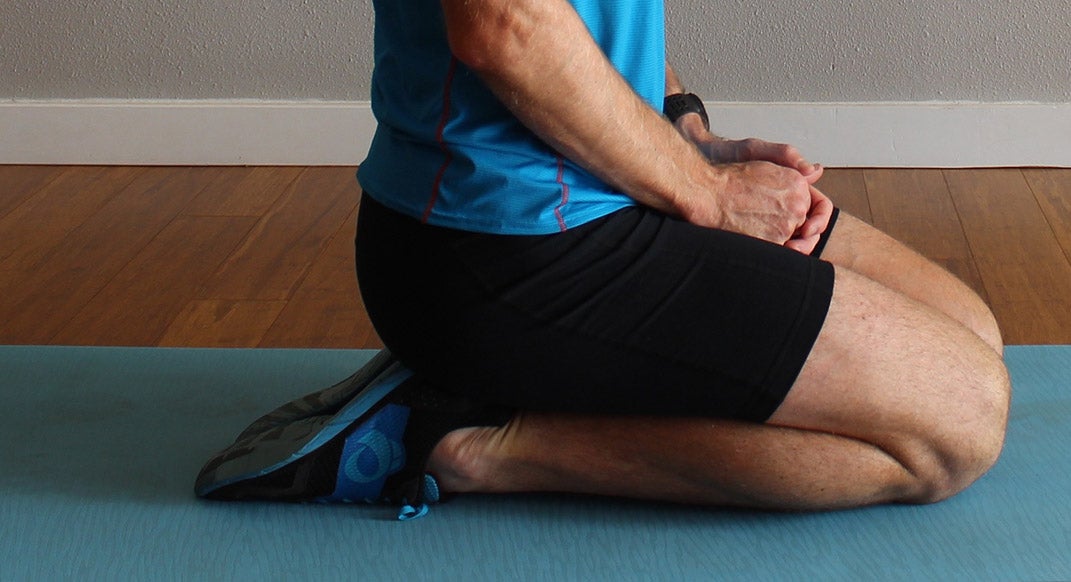Four Steps to Tackling Chronic Achilles Tendon Pain

Tendonitis: it’s one of the most frequently used words in the lexicon of running-related injuries, and comes in a variety of flavors. Chief among them is Achilles tendon pain.
The Achilles tendon connects the calf muscles to the heel. For runners, it is the lynch pin in propulsion, storing the energy we create when we land and then releasing that energy behind us to generate forward momentum. It is an important, high-stress job, and as a result the Achilles is highly prone to injury. Running too fast, too far, too soon can strain it, as can a variety of biomechanical errors.
Achilles tendonitis refers to inflammation from acute injury, with symptoms including warmth, swelling and tenderness. For these kinds of injuries, the prescription is almost always to stop running for a period of time.
RELATED: Ask The Coach: To Stretch Or Not To Stretch?
However, a large majority of Achilles-tendon pain falls into another, altogether different category: chronic Achilles tendinopathy. Unlike tendonitis, tendinopathy often stems from overuse, and exists when the tendon is not inflamed, but simply tight and painful.
In these cases, rest alone is often insufficient if stiffness and weakness lingers. At the same time, a standard physiotherapy regimen of stretching and strengthening often stalls from a failure to address running efficiency and form.
As a physical therapist, I have found that the most complete, expedient, and sustained recovery from chronic Achilles tendinopathy often requires a multidimensional approach, tackling mobility, strength, stability, efficiency and pacing all at once.
The Four Dimensions of Care
Mobility: full and healthy motion of muscles, tendons and joints.
Stability and strength: the ability to fully and powerfully move a segment on a stable base.
Efficiency: moving in such a way that maximizes propulsion and limits wasted (and pain-generating) energy.
Pacing: gradual progression of activity, without overloading healing tissue.
Applying the Four Dimensions of Care to the Achilles Tendon
Soft-tissue mobilization: massage and stretch the tissue
Massage not only the tendon, but also the foot tissues and the entire calf. This can be done professionally with a deep-tissue massage, or with foam rolling or a stick massage. Self active-release techniques can also be helpful: applying pressure to the Achilles tendon where it is tight, then actively (or passively) pumping the ankle.
Short bouts of frequent stretching also helps increase and maintain mobility. This is best done after some soft-tissue mobilization. Stretch for short periods (10 to 60 seconds) and alternate legs, stretching both the affected and the unaffected sides. Stretches to consider include both the standard wall ankle-dorsiflexion stretch and a plantarflexion stretch (pull your foot toward your buttocks, or simply sit on your heels while kneeling).
RELATED: Stronger Ankles For Stronger Running
Ankle stability: strengthen the calf-Achilles complex
Go beyond a standard heel raise. If the pain is not acute, consider doing small single leg hops, maintaining a “tall” leg position, with only a slight amount of ankle and knee bend. Sets of 10 quick hops provide functional strength and stability to the entire leg. They also help to facilitate quicker tendon healing, as quick-bounce plyometric activity has been shown to be most effective at scar-tissue remodeling for chronic tendinopathy.
Efficiency: avoid over-striding; stay tall & forward
The number-one factor in chronic Achilles pain is over-striding. Over-striding occurs when the foot lands significantly in front of the body. Ideal running mechanics place the trunk in a forward-leaning position, with the foot landing beneath the chest and then pushing behind the body. Avoiding over-striding can be as easy as increasing forward lean. This may sound counterintuitive, but it nearly always lessens landing stress.
Staying “tall” throughout the stride also decreases Achilles tendon stress. When the knees sink down in the landing phase of the running stride, the result is a passive over-stretch that can cause repetitive strain to the calf and Achilles. Keeping the leg nearly straight throughout the landing and stance phase limits that over-stretch, and also increases push-off power.
RELATED: Ask The Coach: Achilles Tightness
Pacing: be patient
Chronic Achilles-tendon pain is very pesky. It requires a delicate balance of stress: small but substantial bouts of activity (including stretching, strength and running loads) balanced with frequent bouts of rest. In your return from Achilles pain, having fully addressed mobility, stability and efficiency, progress gradually, even if that means running a mile at a time. Your goal should not be zero pain, but to feel a little better each day. If you do, then go another mile. Then another. Before you know it, you’ve broken the pain cycle!
Joe Uhan is a physical therapist, coach and ultramarathon runner. He has a Master’s Degree in Kinesiology and a Doctorate in Physical Therapy, and is a USATF Level II Certified Coach. He ran his first ultra at Autumn Leaves 50 Mile in 2010, and since has placed 4th at the 2015 USATF 100K Trail Championships (and 3rd in 2012), second at the 2014 Waldo 100K and finished M9 at the 2012 Western States 100. He owns and operates Uhan Performance Physiotherapy in Eugene, Oregon, and offers online coaching and running analysis at Uhanperformance.com.